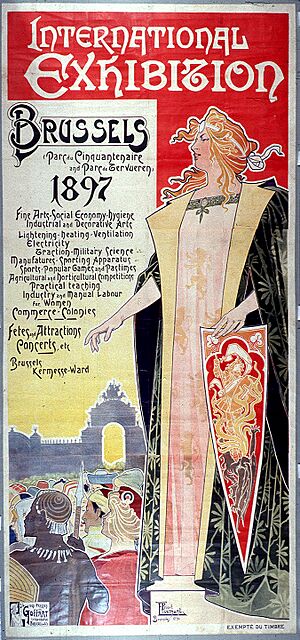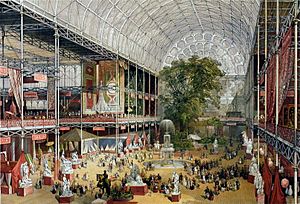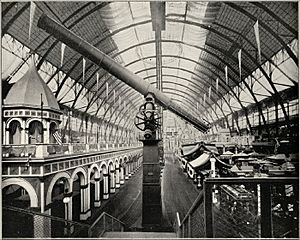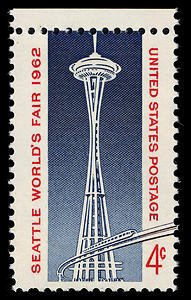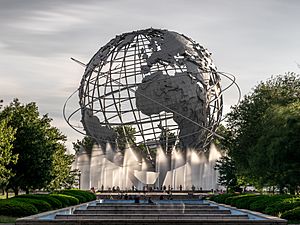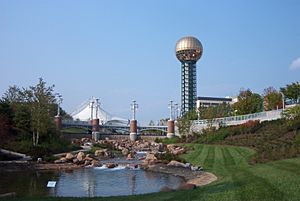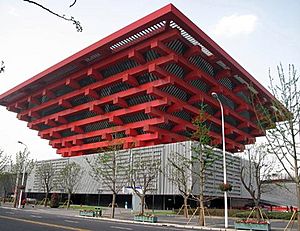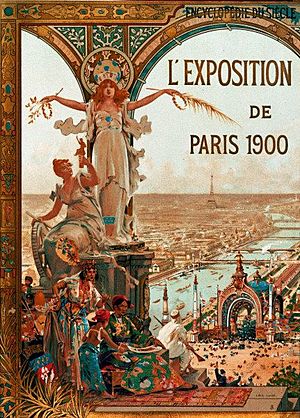World's fair facts for kids
A world's fair (also called a universal exhibition or expo) is a huge global event. It's designed to show off the cool things different countries have achieved. These fairs happen in various places around the world for a few months.
In the United States, people usually say "world's fair." In Europe and Asia, they often use the French term, Exposition universelle, which means "universal exhibition." You might also hear "World Expo" or "Specialised Expo." The short word "expo" has been used for these events since at least 1958.
Since 1928, an organization called the Bureau International des Expositions (BIE) helps organize these international exhibitions. There are four main types: World Expos, Specialised Expos, Horticultural Expos (which focus on plants and gardens), and the Milan Triennial (an art and design show).
Osaka, Japan is currently hosting the World Expo in 2025. Astana, Kazakhstan hosted the most recent Specialised Expo in 2017. Doha, Qatar hosted the most recent Horticultural Expo, which ended in 2024.
Contents
History of World's Fairs
The very first world's fair happened in Prague (now in the Czech Republic) in 1791. It showed off the amazing manufacturing skills of the region.
France also had its own national exhibitions. A big one was the French Industrial Exposition of 1844 in Paris. Then, in 1851, the famous "Great Exhibition of the Works of Industry of All Nations" took place in the Crystal Palace in Hyde Park, London, United Kingdom. This idea came from Prince Albert, who was Queen Victoria's husband.
World's fairs have changed a lot over time. We can see three main periods in their history. These are the time of industrialization, the time of cultural exchange, and the time of nation branding.
Industrialization (1851–1938)
The first period, from about 1850 to 1938, was all about "industrialization." During these years, world expos mainly focused on trade. They showed off new technologies and inventions. These fairs were places to see the latest science and tech from around the globe.
Many famous inventions, like the telephone, were first shown during this time. This era helped set the basic style of what a world's fair would be like.
Cultural Exchange (1939–1987)
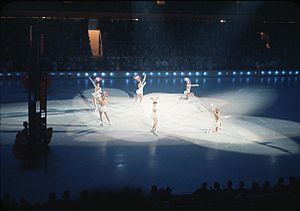
The 1939–1940 New York World's Fair started a new trend. These fairs focused less on just technology. Instead, they aimed more at cultural themes and social progress. For example, the 1939 fair's theme was "Building the World of Tomorrow."
The 1964–1965 New York World's Fair had the theme "Peace Through Understanding." The 1967 International and Universal Exposition in Montreal was called "Man and His World." These fairs encouraged people from different cultures to understand each other better. They also continued to share new technologies.
The 1967 Montreal fair was promoted as Expo 67. Organizers started using "Expo" instead of "world's fair." This word was already popular in French. Even the Montreal Expos, a former baseball team, was named after the 1967 fair.
Nation Branding (1988–Present)
Starting with World Expo 88 in Brisbane, countries began using expos to improve their national image. They did this through their special pavilions. Countries like Finland, Japan, Canada, France, and Spain are good examples.
A study showed that for 73% of countries at Expo 2000, improving their national image was the main goal. Pavilions became like big advertisements for a country. The Expo became a way for "nation branding." For example, Spain used Expo '92 and the 1992 Summer Olympics to show it was a modern, democratic country. It also showed its important role in the European Union and the world.
At Expo 2000 Hanover, countries built their own unique buildings. They spent a lot of money, about €12 million each. Even though it's hard to measure the exact benefits, one study found that the Dutch pavilion (which cost about €35 million) brought in around €350 million for the Dutch economy.
Types of Expos
Today, there are two main types of international exhibitions. These are World Expos (also called International Registered Exhibitions) and Specialised Expos (International Recognised Exhibitions). World Expos are the biggest events.
At World Expos, countries usually build their own pavilions. This makes them the most impressive and expensive expos. They can last between six weeks and six months. Since 1995, there must be at least five years between two World Expos. World Expo 2015 was held in Milan, Italy, from May 1 to October 31, 2015.
Specialised Expos are smaller and cost less money. They also last for a shorter time, usually between three weeks and three months. Their total size cannot be more than 25 acres. Organizers must build pavilions for the participating countries for free. The largest country pavilions can't be bigger than 1,000 square meters. Only one Specialised Expo can happen between two World Expos.
The BIE also recognizes two other types of international exhibitions. These are horticultural exhibitions, which are garden fairs where countries show off gardens and plant displays. The other is the Milan Triennial, an art and design exhibition held in Milan, Italy.
World Expos: Big Themes
World Expos (International Registered Exhibitions) cover big themes that affect everyone. These themes are about human experience. Countries and companies must follow the theme in their displays. Registered expos happen every five years. They are more expensive because countries design their pavilions from scratch.
Because of this, nations compete to have the most amazing building. For example, Japan, France, Morocco, and Spain had very cool pavilions at Seville Expo '92. Sometimes, simpler buildings are used to save money for developing countries. Or, countries from the same area might share space.
In the 21st century, the BIE decided to hold World Expos every five years. This helps reduce how much money countries spend. It also helps avoid conflicts with the Summer Olympics. World Expos are limited to every five years, with Specialised Expos in between.
Specialised Expos: Specific Themes
Specialised Expos (International Recognized Exhibitions) usually have a very specific theme. Examples include "Future Energy" (Expo 2017 Astana), "The Living Ocean and Coast" (Expo 2012 Yeosu), or "Leisure in the Age of Technology" (Brisbane, Expo '88). These themes are much more focused than the broad themes of World Expos.
Specialized Expos are usually smaller and cheaper for the host city and participants. This is because the building costs are lower. Countries only need to decorate pavilion space that the organizers provide for free. Countries can then add their own colors and designs to the outside. They fill the inside with their own content.
Horticultural Expos: Green and Growing
Horticultural Expos (A1 International Horticultural Exhibitions) are also organized by the International Association of Horticultural Producers. Like Specialised Expos, they have a specific theme. Some themes have been "Green Desert, Better Environment" (International Horticultural Expo 2023 Doha Qatar), "Growing Green Cities" (Floriade 2022), or "Building a Beautiful Home Featuring Harmonious Coexistence between Man and Nature" (Expo 2019).
These exhibitions aim to help countries, plant growers, and farming industries work together. They share ideas and solutions. They focus on important topics like healthy living, green economies, sustainable ways of life, education, and new ideas.
List of Expos
Here is a list of official world exhibitions, including Universal, International/Specialised, and Horticultural Expos. This list comes from the Bureau International des Expositions.
World Expos
| # | Name of exposition | Dates | Area (ha) | Visitors | Participants | Theme |
|---|---|---|---|---|---|---|
| 1 | 1 May – 11 October 1851 | 10.40 | 6,039,195 | 25 | Industry of all Nations | |
| 2 | 15 May – 15 November 1855 | 15.20 | 5,162,330 | 28 | Agriculture, Industry and Fine Arts | |
| 3 | 1 May – 1 November 1862 | 11 | 6,096,617 | 39 | Industry and Art | |
| 4 | 1 April – 3 November 1867 | 68.70 | 15,000,000 | 42 | Agriculture, Industry and Fine Arts | |
| 5 | 1 May – 31 October 1873 | 233 | 7,255,000 | 35 | Culture and Education | |
| 6 | 10 May – 10 November 1876 | 115 | 10,000,000 | 35 | Arts, Manufactures and Products of the Soil and Mine | |
| 7 | 20 May – 10 November 1878 | 75 | 16,156,626 | 35 | New Technologies | |
| 8 | 1 October 1880 – 30 April 1881 | 25 | 1,330,000 | 33 | Arts, Manufactures and Agricultural and Industrial Products of all Nations | |
| 9 | 8 April – 10 December 1888 | 46.50 | 2,300,000 | 30 | Fine and Industrial Art | |
| 10 | 5 May – 31 October 1889 | 96 | 32,250,297 | 35 | Celebration of the centenary of the French revolution | |
| 11 | 1 May – 3 October 1893 | 290 | 27,500,000 | 19 | Fourth centenary of the discovery of America | |
| 12 | 10 May – 8 November 1897 | 36 | 6,000,000 | 27 | Modern Life | |
| 13 | 15 April – 12 November 1900 | 120 | 50,860,801 | 40 | 19th century: an overview | |
| 14 | 30 April – 1 December 1904 | 500 | 19,694,855 | 60 | Celebration of the centennial of the Louisiana Purchase | |
| 15 | 27 April – 6 November 1905 | 70 | 7,000,000 | 35 | Commemoration of the 75th anniversary of independence | |
| 16 | 28 April – 11 November 1906 | 100 | 4,012,776 | 40 | Transportation | |
| 17 | 23 April – 7 November 1910 | 30 | 13,000,000 | 26 | Works of Art and Science, Agricultural and Industrial Products of All Nations | |
| 18 | 26 April – 3 November 1913 | 130 | 9,503,419 | 24 | Peace, Industry and Art | |
| 19 | 1 January 1915 – 1 January 1917 | 260 | 3,747,916 | 24 | Celebrating the opening of the Panama Canal | |
| 20 | 20 February – 4 December 1915 | 254 | 18,876,438 | 41 | Celebrating the opening of the Panama Canal | |
| 21 | 20 May 1929 – 15 January 1930 | 118 | 5,800,000 | 29 | Industry, Art and Sport | |
| 22 | 27 May 1933 – 31 October 1934 | 170 | 38,872,000 | 21 | The independence among Industry and scientific research. | |
| 23 | 27 April – 3 November 1935 | 152 | 20,000,000 | 25 | Transport | |
| 24 | 25 May – 25 November 1937 | 104 | 31,040,955 | 35 | Arts and technology in modern life | |
| 25 | 30 April 1939 – 27 October 1940 | 500 | 45,000,000 | 54 | Building the World of Tomorrow | |
| 26 | 8 December 1949 – 8 June 1950 | 30 | 250,000 | 18 | The festival of Peace | |
| 27 | 17 April – 19 October 1958 | 200 | 41,454,412 | 39 | A World View: A New Humanism | |
| 28 | 21 April – 21 October 1962 | 30 | 9,000,000 | 49 | Man in the Space Age | |
| 29 | 28 April – 29 October 1967 | 400 | 50,306,648 | 62 | Man and his World | |
| 30 | 15 March – 13 November 1970 | 330 | 64,218,770 | 67 | Progress and Harmony for Mankind | |
| 31 | 20 April – 12 October 1992 | 215 | 41,814,571 | 108 | The Age of Discovery | |
| 32 | 1 June – 31 October 2000 | 160 | 18,100,000 | 174 | Humankind – Nature – Technology | |
| 33 | 25 March – 25 September 2005 | 173 | 22,049,544 | 121 | Nature's Wisdom | |
| 34 | 1 May – 31 October 2010 | 523 | 73,085,000 | 100 | Better City, Better Life | |
| 35 | 1 May – 31 October 2015 | 110 | 22,200,000 | 139 | Feeding the Planet, Energy for Life | |
| 36 | 1 October 2021 – 31 March 2022 | 438 | 24,102,967 | 200 | Connecting Minds, Creating the Future | |
| 37 | 13 April – 13 October 2025 | 155 | 165 | Designing Future Society for Our Lives | ||
| 38 | 1 October 2030 – 31 March 2031 | 600 | Foresight for Tomorrow |
Specialised Expos
| Name of exposition | Dates | Area | Visitors | Participants | Theme |
|---|---|---|---|---|---|
| 15 May – 1 June 1936 | N/A | N/A | 8 | Aviation | |
| 14–22 May 1938 | N/A | N/A | 25 | Aerospace | |
| 20 May – 2 September 1939 | 50 | N/A | 8 | Art of Water | |
| 10 July – 15 August 1947 | 6.35 | N/A | 14 | Urbanism and Housing | |
| 27 July – 13 August 1949 | N/A | N/A | 14 | Sport and physical culture | |
| 24 September – 9 October 1949 | 110 | N/A | N/A | Rural Habitat | |
| 28 April – 20 May 1951 | 15 | 1,500,000 | 24 | Textile | |
| 26 July – 31 October 1953 | 12 | 1,700,000 | N/A | Agriculture | |
| 22 September – 14 October 1953 | 4.60 | 600,000 | 13 | Conquest of the Desert | |
| 15 May – 15 October 1954 | 100 | N/A | 25 | Navigation | |
| 25 May – 15 June 1955 | N/A | 120,000 | 11 | Sport | |
| 10 June – 28 August 1955 | N/A | N/A | 10 | Modern Man in the Environment | |
| 21 May – 20 June 1956 | 55 | N/A | N/A | Citrus | |
| 6 July – 29 September 1957 | N/A | 1,000,000 | 13 | Reconstruction of Hansa District | |
| 1 May – 31 September 1961 | 50 | 5,000,000 | 19 | Man and his Work – A Century of Technological and Social Developments | |
| 25 June – 3 October 1965 | 50.20 | 2,500,000 | 31 | Transport | |
| 6 April – 6 October 1968 | 39 | 6,384,482 | 23 | The confluence of civilizations in the Americas | |
| 27 August – 30 September 1971 | 35 | 1,900,000 | 35 | The Hunt through the World | |
| 4 May – 2 November 1974 | 40 | 5,600,000 | 56 | Celebrating Tomorrow's Fresh New Environment | |
| 20 July 1975 – 18 January 1976 | 100 | 3,485,750 | 35 | The Sea We would like to See | |
| 14 June – 12 July 1981 | 51 | N/A | 70 | Earth – Planet of Life | |
| 1 May – 31 October 1982 | 29 | 11,127,780 | 16 | Energy turns the World | |
| 12 May – 11 November 1984 | 34 | 7,335,000 | 15 | The World of rivers – Fresh Water as a source of life | |
| 17 March – 16 September 1985 | 100 | 20,334,727 | 48 | Dwellings and surroundings – Science and Technology for Man at Home | |
| 4–30 November 1985 | 5.80 | 1,000,000 | 54 | Inventions | |
| 2 May – 13 October 1986 | 70 | 22,111,578 | 55 | Transportation and Communication: World in Motion – World in Touch | |
| 30 April – 30 October 1988 | 40 | 18,560,447 | 36 | Leisure in the age of Technology | |
| 7 June – 7 July 1991 | N/A | N/A | 9 | The activity of young people in the service of a World of Peace | |
| 15 May – 15 August 1992 | 6 | 817,045 | 52 | Christopher Colombus: The Ship and the Sea | |
| 7 August – 7 November 1993 | 90.10 | 14,005,808 | 141 | The Challenge of a New Road of Development | |
| 22 May – 30 September 1998 | 50 | 10,128,204 | 160 | The Oceans: a heritage for the Future | |
| 14 June – 14 September 2008 | 25 | 5,650,943 | 108 | Water and sustainable development | |
| 14 May – 12 August 2012 | 25 | 8,203,956 | 103 | The living ocean and coast | |
| 10 June – 10 September 2017 | 35 | 3,977,545 | 137 | Future Energy | |
| 15 May – 15 August 2027 | 25 | Play for Humanity – Sport and Music for All |
Horticultural Expos
| Name of exposition | Dates | Area | Visitors | Participants | Theme |
|---|---|---|---|---|---|
| 25 March – 25 September 1960 | 50 | 4,000,000 | N/A | International Horticulture | |
| 26 April – 13 October 1963 | 76 | 5,400,000 | 35 | Horticulture of all Categories from the Point of View of Economics and Culture | |
| 16 April – 11 October 1964 | 100 | 2,100,000 | 28 | International Horticulture | |
| 23 April – 5 October 1969 | 28 | 2,400,000 | 17 | Flowers of France and Flowers of the World | |
| 26 March – 1 October 1972 | 75 | 4,300,000 | N/A | Efforts accomplished by International Horticulture | |
| 27 April – 7 October 1973 | 76 | 5,800,000 | 50 | International Horticulture | |
| 18 April – 14 October 1974 | 100 | 2,600,000 | 30 | International Horticulture | |
| 17 May – 1 September 1980 | 40 | N/A | 23 | Relationship between man's socio-cultural activities and his physical environment | |
| 8 April – 10 October 1982 | 50 | 4,600,000 | 17 | International Horticulture | |
| 28 April – 9 October 1983 | 72 | 11,600,000 | 23 | International Horticulture | |
| 2 May – 14 October 1984 | 95 | 3,380,000 | 29 | The progress accomplished by International and National Horticulture | |
| 1 April – 30 September 1990 | 140 | 23,126,934 | 83 | The Harmonious Coexistence of Nature and Mankind | |
| 10 April – 12 October 1992 | 68 | 3,355,600 | 23 | Horticulture is being involved in a continuous process of renewal | |
| 23 April – 17 October 1993 | 64 | 7,311,000 | 40 | City and Nature – Responsible Approach | |
| 1 May – 31 October 1999 | 218 | 9,427,000 | 70 | Man and Nature – Marching into the 21st century | |
| 25 April – 20 October 2002 | 140 | 2,071,000 | 30 | The contribution of the Netherlands horticulture and international horticulture | |
| 25 April – 12 October 2003 | 100 | 2,600,000 | 32 | A Seaside Park. A new flowered world | |
| 1 November 2006 – 31 January 2007 | 80 | 3,848,791 | 32 | To Express the Love for Humanity | |
| 5 April – 7 October 2012 | 66 | 2,046,684 | 38 | Be part of the theatre in nature; get closer to the quality of life | |
| 23 April – 30 October 2016 | 112 | 4,693,571 | 54 | Flowers and Children | |
| 29 April – 7 October 2019 | 503 | 9,340,000 | 110 | Live Green, Live Better | |
| 14 April – 9 October 2022 | 60 | 685,189 | 32 | Growing Green Cities | |
| 2 October 2023 – 28 March 2024 | 80 | N/A | N/A | Green Desert, Better Environment | |
| 19 March – 26 September 2027 | 80 | Scenery of the Future for Happiness | |||
| 10 November 2029 – 28 February 2030 | 80 | Nature and Greenery: Envisioning the Green Future |
What's Left Behind: Expo Legacies
Remaining Structures

Most buildings at world's fairs are temporary. They are taken down after the fair ends. But some famous towers and buildings stay. The most famous is the Eiffel Tower, built for the Exposition Universelle (1889) in Paris. Even though some people didn't like it at first, it's now a symbol of Paris.
Other structures that remain from these fairs include:
- 1851 – London: The Crystal Palace was so successful it was moved to be permanent. Sadly, it burned down in 1936.
- 1876 – Philadelphia: Memorial Hall from the Centennial Exposition is still in Fairmount Park, Philadelphia. It's now home to the Please Touch Museum.
- 1880 – Melbourne: The Royal Exhibition Building in Melbourne was built for the Melbourne International Exhibition (1880). It's now a World Heritage Site.
- 1893 – Chicago: The Museum of Science and Industry is in the former Palace of Fine Arts. This is one of the last buildings from the World's Columbian Exposition.
- 1894 – San Francisco: The Japanese Tea Garden in Golden Gate Park is a main part of the California Midwinter International Exposition of 1894.
- 1897 – Nashville: A full-size copy of the Parthenon was built for the Tennessee Centennial and International Exposition. It still stands in Centennial Park.
- 1900 – Paris: The Grand Palais and Petit Palais are still standing.
-
1904 – St. Louis: The St. Louis Art Museum and Brookings Hall at Washington University in St. Louis are from the Louisiana Purchase Exposition. The aviary in Forest Park became the St. Louis Zoo.
 Brookings Hall at Washington University in St. Louis, the administration building of the 1904 World's Fair
Brookings Hall at Washington University in St. Louis, the administration building of the 1904 World's Fair - 1906 – Milan: The Civic Aquarium of Milan from the Milan Exposition is still open today.
- 1909 – Seattle: The beautiful landscaping from the Alaska–Yukon–Pacific Exposition (AYPE) is now part of the University of Washington campus.
- 1915 – San Francisco: The Palace of Fine Arts in San Francisco is a main part of the Panama–Pacific International Exposition. The Bill Graham Civic Auditorium was also built for this fair.
- 1929 – Seville and Barcelona: Many buildings from the fairs in Seville and Barcelona still exist. In Seville, the Spanish Pavilion's Plaza de España is part of a large park.
- 1936 – Johannesburg: Buildings from the Empire Exhibition, South Africa are now part of the University of the Witwatersrand.
- 1939 – New York City: The New York City Building from the 1939 New York World's Fair is now the Queens Museum. The Parachute jump ride was moved to Coney Island.
- 1942 – Rome: The EUR area in Rome was built for a fair planned for 1942. It was cancelled due to World War II. Today, it has offices and museums.
- 1958 – Brussels: In Brussels, the Atomium still stands at the fair site. It's a huge building shaped like an iron crystal.
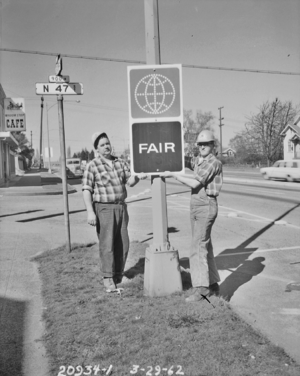
- 1962 – Seattle: The Space Needle from the Century 21 Exposition is a famous Seattle landmark. The Seattle Center Monorail still runs daily. The US pavilion became the Pacific Science Center.
- 1964 – New York City: Many structures still stand. The Unisphere is in Flushing Meadows, Queens. The New York Hall of Science is still a science museum. The New York State Pavilion is being restored.
- 1967 – Montreal: Buildings like Moshe Safdie's Habitat 67, Buckminster Fuller's "Montreal Biosphere", and the French pavilion (now the Montreal Casino) remain from Expo 67.
- 1968 – San Antonio: San Antonio kept the Tower of the Americas, the Institute of Texan Cultures, and the Convention Center from HemisFair '68.
- 1970 – Osaka: The Tower of the Sun was restored and its museum reopened in 2018.
- 1974 – Spokane: Spokane still has its Riverfront Park, which was created for Expo '74.
- 1982 – Knoxville: The Sunsphere from the 1982 World's Fair is still a part of Knoxville's skyline.
- 1984 – New Orleans: The main buildings of the 1984 Louisiana World Exposition became the Ernest N. Morial Convention Center.
- 1986 – Vancouver: In Vancouver, many Expo 86 projects became permanent. These include the Skytrain, Science World, and Canada Place.
- 1988 – Brisbane: The Skyneedle from Expo '88 still stands. The Nepalese Peace Pagoda and the Japan Pond and Garden also remain.
- 1992 – Seville: The pavilions of Seville Expo '92 were turned into a technology park and a theme park.
- 1998 – Lisbon: The main buildings of Expo '98 were made part of the city. Many art pieces are still there.
- 2005 – Nagoya: The home of Satsuki & Mei Kusakabe from the 2005 Expo is still open. It's now part of Ghibli Park.
- 2010 – Shanghai: The China pavilion from Expo 2010 is now the China Art Museum.
- 2015 – Milan: The Italian Pavilion of Expo 2015 remains on its original site.
Reuse of Sites
Some world's fair sites became parks that still have some of the expo features. Examples include:
- Audubon Park, New Orleans: Site of New Orleans's World Cotton Centennial in 1884.
- Jackson Park, Chicago and the Chicago Midway: Site of the 1893 Columbian Exposition.
- Centennial Park, Nashville: Tennessee Centennial Expo in 1897.
- Forest Park, Saint Louis: Home of the Saint Louis Louisiana Purchase Exposition of 1904.
- San Diego: Panama–California Exposition (1915) and California Pacific International Exposition (1935).
- Seattle Center: Century 21 Exposition in 1962.
- Flushing Meadows Park, Queens, New York City: Site of both the 1939 New York World's Fair and the 1964 New York World's Fair.
- Montreal: Expo 67.
- San Antonio: HemisFair '68.
- Expo Commemoration Park, Osaka: Expo '70.
- Riverfront Park, Spokane: Expo '74.
- World's Fair Park, Knoxville: 1982 World's Fair.
- Vancouver: Expo 86.
- Brisbane: Expo '88: now the South Bank Parklands.
- Seville: Seville Expo '92.
- Daejeon (Taejŏn): Expo '93.
- Lisbon: Expo '98 was divided into several structures like the Pavilhão Atlântico and Oceanário.
- Shanghai Expo Park: Expo 2010.
- Rho, Milan, Lombardy District: Expo 2015.
Relocation of Pavilions
Some pavilions have been moved to other countries:
- The Argentine Pavilion from the 1889 Paris was moved to Buenos Aires, Argentina.
- The Chilean Pavilion from 1889 Paris is now in Santiago, Chile, as the Museo Artequin.
- The Peruvian Pavilion from 1900 Paris is now in Lima.
- The Japanese Tower from the 1900 Paris fair was moved to Laken (Brussels).
- The Belgium Pavilion from the 1939 New York World's Fair was moved to Virginia Union University in Richmond, Virginia.
- The USSR Pavilion from Expo 67 is now in Moscow.
- The Sanyo Pavilion from Expo '70 is the Asian Centre at the University of British Columbia in Vancouver.
- The Portugal Pavilion from Expo 2000 is now in Coimbra, Portugal.
- The United Arab Emirates Pavilion from Expo 2010 is now in Saadiyat Island in Abu Dhabi.
- The Bahrain Pavilion from Expo 2015 was moved back to Bahrain. The Azerbaijan Pavilion is in Baku.
- The Save the Children Italy pavilion from Expo 2015 was rebuilt as a school for Syrian refugee children in Lebanon.
The Brussels Expo '58 moved many pavilions within Belgium. For example, the Jacques Chocolats pavilion became a swimming pool in Diest.
Other Lasting Impacts
Many exhibits and rides created by Walt Disney and his company for the 1964 New York World's Fair were moved to Disneyland. Rides like "It's a Small World" and "Great Moments with Mr. Lincoln" are still running. The idea of a permanent world's fair came to life with the Disney Epcot theme park in Florida. Epcot has national pavilions and exhibits about technology and the future, much like a world's fair.
Sometimes, other reminders of the fairs remain. In the New York City Subway, signs pointing to Flushing Meadows–Corona Park are still there from the 1964–1965 event. Many fairs also produced special postage stamps and commemorative coins.
See also
 In Spanish: Exposición Universal para niños
In Spanish: Exposición Universal para niños
- Agricultural show
- State fair


